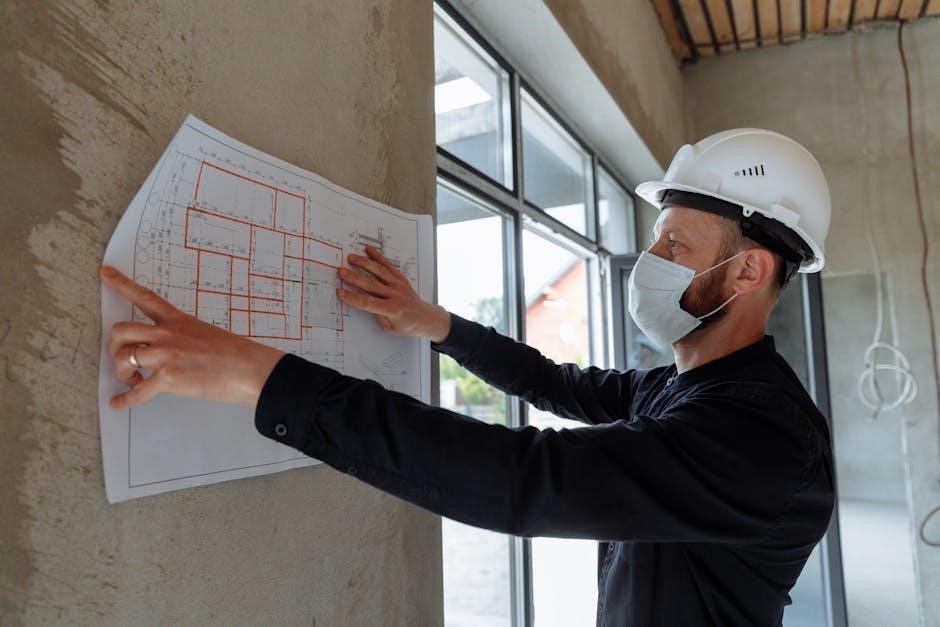MRI protocols are the backbone of effective imaging, ensuring high-quality scans and accurate diagnoses. They guide parameter selection, from pulse sequences to patient positioning, optimizing image quality and diagnostic accuracy.
1.1 Definition and Importance of MRI Protocols
MRI protocols are standardized sets of imaging parameters and sequences designed to optimize image quality for specific anatomical regions and clinical indications. They serve as blueprints guiding the acquisition process, ensuring consistency and reproducibility in scans. Protocols are crucial for obtaining high-quality images that facilitate accurate diagnoses and treatment planning. By minimizing artifacts and optimizing signal-to-noise ratios, they enhance the visualization of anatomical structures and pathological processes. Well-designed protocols ensure patient safety, reduce scan times, and improve diagnostic accuracy, making them indispensable in modern radiology. Their importance lies in their ability to standardize imaging practices, ensuring reliable and comparable results across different patients and institutions.
1.2 Role of Planning in MRI Imaging
Planning is essential in MRI imaging to ensure optimal image quality, patient safety, and diagnostic accuracy. It involves selecting appropriate sequences, parameters, and imaging planes based on the clinical indication. Proper planning minimizes artifacts, reduces scan time, and enhances patient comfort. It also ensures compliance with safety guidelines, such as screening for contraindications and managing contrast agent administration. Effective planning considers patient characteristics, such as age, weight, and medical history, to tailor the exam to individual needs. Additionally, it involves positioning the patient correctly to align the anatomy of interest within the magnetic field. Collaborative planning between radiologists and technologists further ensures that the exam meets diagnostic requirements, leading to accurate interpretations and effective patient care.
1.3 Overview of MRI Protocol Design
MRI protocol design involves creating structured sequences to optimize image acquisition for specific clinical needs. It includes selecting appropriate pulse sequences, imaging planes, and parameters like slice thickness and field of view. Protocols are tailored to anatomical regions, such as brain, spine, or abdomen, ensuring detailed visualization of tissues and pathologies. The design balances image quality, scan time, and patient comfort, while minimizing artifacts. It also considers hardware capabilities, patient characteristics, and safety guidelines. Effective protocol design ensures diagnostic accuracy, facilitating timely and precise clinical decisions. Regular updates and customization further enhance protocol effectiveness, adapting to advancing technologies and evolving clinical requirements.
Fundamentals of MRI Protocols
MRI protocols are essential for producing high-quality images, involving pulse sequences and imaging parameters. They optimize image quality and diagnostic accuracy, serving as blueprints for data acquisition.
2.1 Key Components of MRI Protocols
MRI protocols consist of pulse sequences, imaging parameters, and patient positioning. Pulse sequences like T1-weighted and T2-weighted are fundamental, providing tissue contrast. Imaging parameters such as slice thickness, field of view, and matrix size optimize image resolution. Patient positioning ensures proper alignment, minimizing artifacts. Contrast agents may be included to enhance tissue differentiation. These components work together to produce high-quality images tailored to specific anatomical regions and clinical needs, ensuring accurate diagnoses and effective treatment planning.

2.2 Pulse Sequences and Imaging Parameters
Pulse sequences are core to MRI protocols, determining tissue contrast and image quality. T1-weighted sequences highlight anatomical structures, while T2-weighted sequences emphasize fluid and inflammation. FLAIR and STIR sequences suppress specific signals, enhancing lesion visibility. Imaging parameters like slice thickness, field of view, and matrix size balance resolution and scan time. Repetition and echo times (TR/TE) influence tissue contrast. These parameters are optimized for specific clinical needs, ensuring detailed visualization of target anatomy and pathology. Proper selection of pulse sequences and imaging parameters is critical for diagnostic accuracy and effective patient care.
2.3 Principles of Protocol Optimization
Protocol optimization balances image quality, scan time, and patient comfort. It involves minimizing artifacts, optimizing signal-to-noise ratio (SNR), and tailoring parameters to clinical needs. Key factors include sequence selection, repetition and echo times (TR/TE), and field of view. Contrast agents are used judiciously to enhance diagnostic value. Parameter adjustments aim to reduce motion and flow artifacts while maintaining spatial resolution. Patient-specific factors, such as age and condition, guide protocol tweaks. Efficient protocols ensure timely exams without compromising diagnostic accuracy, enhancing workflow and patient satisfaction. Regular updates and adherence to best practices keep protocols aligned with advancing MRI technology and clinical demands.

Clinical Applications of MRI Protocols
MRI protocols are applied across diverse clinical applications, including brain, spine, musculoskeletal, abdominal, and pelvic imaging, utilizing specific sequences for precise anatomical and pathological assessments.
3.1 Brain and Orbit MRI Protocols
Brain and orbit MRI protocols are designed to provide detailed imaging of the brain, cerebrospinal fluid, and orbital structures. These protocols typically include T1-weighted, T2-weighted, and FLAIR sequences to visualize brain parenchyma, white matter lesions, and cerebrospinal fluid. T1-weighted images are ideal for anatomical detail and contrast enhancement, while T2-weighted images highlight areas of edema or inflammation. FLAIR sequences suppress cerebrospinal fluid signals, enhancing the visibility of white matter lesions. Additional sequences like diffusion-weighted imaging (DWI) are used for acute stroke evaluation. Contrast-enhanced T1-weighted images are often employed to detect tumors, inflammation, or vascular abnormalities. These protocols are essential for diagnosing conditions such as multiple sclerosis, stroke, and orbital pathologies, ensuring precise and accurate clinical interpretations.
3.2 Spine MRI Protocols
Spine MRI protocols are tailored to evaluate the vertebral column, spinal cord, and surrounding soft tissues. These protocols often include sagittal T1-weighted and T2-weighted sequences to assess spinal alignment, disc morphology, and cord compression. Axial T2-weighted images are used to examine the spinal cord, nerve roots, and foramina, while axial T1-weighted sequences provide anatomical detail. Diffusion-weighted imaging (DWI) and FLAIR sequences may be added to evaluate spinal cord lesions or inflammation. Contrast enhancement with gadolinium is often used to highlight areas of inflammation, infection, or tumor involvement. These protocols are essential for diagnosing conditions such as herniated discs, spinal stenosis, and cord abnormalities, ensuring comprehensive imaging for accurate clinical interpretations.
3.3 Musculoskeletal (MSK) MRI Protocols

Musculoskeletal (MSK) MRI protocols are designed to evaluate joints, muscles, tendons, ligaments, and bones. These protocols typically include T1-weighted, T2-weighted, and STIR sequences to provide detailed anatomical information and identify abnormalities. T1-weighted sequences excel in visualizing bone marrow, while T2-weighted sequences highlight soft tissue structures like tendons and ligaments. STIR sequences effectively differentiate between fluid and soft tissue, highlighting edema and inflammation. Contrast enhancement with gadolinium is often used to further delineate structures and highlight areas of inflammation or injury. Specialized sequences, such as fat-suppressed T1-weighted images, may be employed to enhance diagnostic accuracy. These protocols are tailored to specific joints, ensuring comprehensive imaging for accurate diagnosis of musculoskeletal conditions.
3.4 Abdominal MRI Protocols
Abdominal MRI protocols are designed to evaluate organs such as the liver, pancreas, kidneys, and gastrointestinal tract. These protocols often combine T1-weighted, T2-weighted, and diffusion-weighted imaging (DWI) sequences, sometimes with gadolinium contrast. T1-weighted sequences are useful for visualizing anatomical structures and fatty infiltration, while T2-weighted sequences detect fluid and inflammation. DWI sequences identify restricted diffusion, often indicative of tumors. Contrast enhancement highlights vascular structures and lesions, aiding in accurate diagnoses. These protocols are tailored to assess various abdominal pathologies, ensuring comprehensive imaging for conditions like liver disease, pancreatic disorders, and inflammatory processes. They balance diagnostic accuracy with patient safety and comfort.
3.5 Pelvic MRI Protocols
Pelvic MRI protocols are tailored to visualize the bladder, prostate, uterus, ovaries, and surrounding tissues. They typically include T1-weighted, T2-weighted, and diffusion-weighted sequences, often with gadolinium contrast. T1-weighted images delineate anatomical structures, while T2-weighted sequences detect fluid and inflammation. Diffusion-weighted imaging identifies restricted diffusion, often linked to tumors. Contrast enhancement highlights vascular structures and lesions, aiding in precise diagnoses. These protocols are essential for assessing conditions like prostate cancer, uterine abnormalities, and ovarian pathologies. They ensure comprehensive imaging while balancing diagnostic accuracy, patient safety, and comfort, making them invaluable for pelvic region evaluations.
Protocol Design and Planning
Protocol design involves tailoring MRI sequences to specific clinical needs, balancing image quality, scan time, and patient safety. It requires expertise in pulse sequences and patient factors.
4.1 Factors Influencing Protocol Design
The design of MRI protocols is influenced by multiple factors, including clinical indication, patient characteristics, hardware capabilities, and expert preferences. Clinical indication determines the anatomical region and pathology of interest, guiding sequence selection. Patient factors such as age, weight, and allergies impact parameter choices and safety measures. MRI hardware and software limitations also play a role, as different systems offer varying capabilities. Additionally, the expertise and preferences of radiologists and referring physicians shape protocol design to meet diagnostic needs. These factors must be carefully balanced to ensure optimal image quality, patient safety, and diagnostic accuracy, making protocol design a complex yet critical process in MRI imaging.
4.2 Clinical Indication and Patient Characteristics
Clinical indication and patient characteristics are central to MRI protocol design. The specific clinical question determines the anatomical region and sequences used, ensuring relevant pathology is captured. Patient factors, such as age, weight, and medical history, influence parameter selection, including slice thickness and field of view. Allergies or contraindications, like metal implants, dictate safety precautions and contrast usage. Patient positioning and imaging planes are tailored to the region of interest, optimizing diagnostic yield. These considerations ensure protocols are personalized, balancing image quality with patient safety and comfort, ultimately enhancing diagnostic accuracy and clinical decision-making.
4.3 Hardware and Software Considerations
Hardware and software considerations significantly influence MRI protocol design. The type of MRI system (1.5T or 3T) and its capabilities dictate available pulse sequences and image quality; Coil selection, such as phased-array or surface coils, enhances signal-to-noise ratio for specific anatomical regions. Gradient performance affects scan speed and spatial resolution. Software features, including advanced pulse sequences and image reconstruction algorithms, optimize image quality and reduce artifacts. Compatibility with patient-specific factors, like metal implants, must also be considered. These technical limitations and capabilities guide parameter selection, ensuring protocols are tailored to the system’s strengths while addressing clinical needs. This balance ensures efficient and effective imaging outcomes.
4.4 Expert Preferences and Diagnostic Needs
Expert preferences and diagnostic needs play a pivotal role in shaping MRI protocols. Radiologists and referring physicians often tailor protocols to specific clinical scenarios, ensuring that imaging parameters align with diagnostic goals. For instance, the selection of pulse sequences, contrast agents, and imaging planes is influenced by the expertise of the interpreting radiologist. Additionally, specialized sequences or advanced imaging techniques may be incorporated based on the radiologist’s preference to enhance diagnostic accuracy. Patient-specific factors, such as suspected pathology or anatomical complexity, further guide these decisions. Ultimately, the integration of expert input ensures that MRI protocols are optimized for clarity, accuracy, and patient care, addressing the unique needs of each clinical case.

Safety Considerations in MRI Planning

Safety is paramount in MRI planning, involving patient screening for contraindications, safe contrast administration, and emergency preparedness to minimize risks and ensure a secure imaging environment.
5.1 Patient Screening and Contraindications
Patient screening is critical to ensure safety during MRI procedures. It involves assessing medical history, metal implants, claustrophobia, and renal function to identify contraindications. Ferromagnetic objects, pacemakers, and certain tattoos may pose risks. Screening tools include questionnaires and physical exams to detect unsafe conditions. Patients with severe claustrophobia may require sedation or open MRI. Renal insufficiency necessitates caution with gadolinium-based contrast agents. Proper screening prevents adverse events, ensuring a safe imaging environment. Thorough evaluation of each patient’s unique conditions is essential to avoid complications and optimize diagnostic outcomes.
5.2 Contrast Agent Safety and Administration
Contrast agents, such as gadolinium-based compounds, enhance MRI image clarity by altering tissue signal properties. Their administration requires careful patient assessment to minimize risks. Nephrogenic systemic fibrosis (NSF) is a rare but serious complication in patients with severe renal impairment. Therefore, renal function must be evaluated before contrast use. Patient history, including allergies and kidney disease, is critical for safe administration; Informed consent and monitoring for adverse reactions are essential. Proper dosing and timing of contrast administration ensure diagnostic efficacy while maintaining safety. Protocols often include guidelines for emergency preparedness in case of allergic reactions or other complications.
5.3 Emergency Preparedness and Response

Emergency preparedness is critical in MRI planning to ensure patient and staff safety. Protocols must include rapid response strategies for adverse reactions, such as allergic responses to contrast agents or claustrophobia. MRI suites should be equipped with emergency kits, including oxygen, defibrillators, and first aid supplies. Staff must undergo regular training in emergency procedures, such as cardiopulmonary resuscitation (CPR) and anaphylaxis management. Clear communication channels and emergency call systems are essential for swift intervention. Regular drills and updates to emergency plans ensure readiness for unexpected situations, minimizing risks and ensuring timely, effective responses to critical incidents during MRI examinations.
Optimizing Image Quality
Optimizing MRI image quality involves minimizing artifacts, enhancing signal-to-noise ratio (SNR), and ensuring proper patient positioning. These factors collectively improve diagnostic accuracy and image clarity for accurate interpretations.

6.1 Minimizing Artifacts in MRI
Minimizing artifacts in MRI is crucial for achieving high-quality images. Common artifacts include motion artifacts, metal artifacts, and susceptibility artifacts. Motion artifacts can be reduced by instructing patients to remain still and using immobilization devices. Metal artifacts, caused by ferromagnetic materials, can be minimized by using artifact-reducing sequences or removing metal objects. Susceptibility artifacts, often seen near air-tissue interfaces, can be addressed by adjusting imaging parameters. Additionally, phase direction and oversampling can help reduce arterial pulsation and swallowing artifacts. Proper patient positioning and sequence optimization are key to minimizing artifacts, ensuring clear and diagnostic images for accurate interpretations.
6.2 Signal-to-Noise Ratio (SNR) Optimization
Signal-to-Noise Ratio (SNR) optimization is critical for producing high-quality MRI images. SNR is influenced by factors such as magnetic field strength, receiver coil quality, and imaging parameters like slice thickness and matrix size. Higher field strength systems generally provide better SNR, while parallel imaging techniques can enhance image quality without sacrificing scan time. Adjusting parameters like bandwidth and echo time can also improve SNR. Additionally, using phased-array coils and ensuring proper patient positioning can maximize signal reception. Optimizing SNR ensures clearer images, enabling better visualization of anatomical structures and pathological processes, which is essential for accurate diagnoses and treatment planning.

6.3 Patient Preparation and Positioning
Patient preparation and positioning are crucial for achieving high-quality MRI images. Proper positioning ensures the anatomy of interest is aligned correctly within the magnetic field, minimizing motion artifacts and enhancing image clarity. Patients should be instructed to remain still during the scan and avoid swallowing or breathing deeply, especially for brain or spinal imaging. Immobilization devices, such as straps or head rests, can help maintain position. Additionally, removing metal objects and ensuring proper gowning are essential for safety and image quality. Accurate positioning also ensures that the desired anatomical structures are fully visualized, optimizing diagnostic accuracy and reducing the need for repeat scans.

Resources and Future Directions
Access comprehensive MRI protocol PDFs and guidelines for various examinations. Stay updated with emerging trends and advancements in MRI technology and techniques for optimal imaging outcomes.
7.1 Accessing MRI Protocol PDFs and Guidelines
Comprehensive MRI protocol PDFs and guidelines are widely available, offering detailed insights into imaging parameters and sequences for various examinations. These resources cover over 138 protocols, including MSK, neuro, and body MRI. Users can download or access these documents to understand specific imaging techniques, such as T1-weighted, T2-weighted, and diffusion-weighted sequences. Many institutions provide updated versions of their protocol books, ensuring adherence to current standards. These PDFs often include practical tips, anatomy illustrations, and clinical indications, making them invaluable for radiologists, technologists, and students. Regular updates ensure that the protocols remain relevant and aligned with advancing MRI technology and clinical practices.
7.2 Emerging Trends in MRI Protocol Development
Emerging trends in MRI protocol development focus on enhancing efficiency, accuracy, and patient-specific care. Advances in AI and machine learning are being integrated to automate protocol optimization, reducing variability and improving image quality. Personalized protocols tailored to individual patient needs are gaining traction, leveraging data analytics to refine imaging parameters. Additionally, there is a growing emphasis on streamlined workflows and reduced scan times without compromising diagnostic value. Continuous updates in hardware and software capabilities, such as higher-field strength systems, are driving innovation in protocol design. These advancements ensure that MRI protocols remain at the forefront of diagnostic imaging, adapting to evolving clinical demands and technological breakthroughs.
7.3 Continuous Learning and Professional Development
Continuous learning is essential for professionals involved in MRI protocols and planning, as advancements in technology and clinical practices evolve rapidly. Staying updated with the latest developments ensures optimal patient care and diagnostic accuracy. Professionals can engage in workshops, webinars, and conferences to expand their knowledge. Access to updated MRI protocol PDFs and guidelines is a valuable resource for ongoing education. Collaboration with peers and experts fosters a culture of shared learning and innovation. Investing time in professional development not only enhances individual skills but also contributes to the collective advancement of MRI imaging, ensuring that professionals remain at the forefront of their field;



